#fort Stanwix
Explore tagged Tumblr posts
Photo

The fascinating story of Fort Stanwix, here at Dougie Does Monuments
0 notes
Text
The History Major instinct to add footnotes to my historical fiction novels because I feel guilty using my Creative License and am afraid no one will go read the Author’s Note at the end...
#the balance of historical fact and the fiction that makes it histfic with forever stall my writing process#no one understands how many times i have argued with myself over breed's hill/bunker hill#now i'm questioning myself for using fort schuyler instead of stanwix#because the current national park is fort stanwix#but they only named it that because they rebuilt the original fort that was there first#when it WAS fort stanwix#but in 1777 it was renamed fort schuyler for gen. philip schuyler because that's what armies did back then#primary sources mostly call it schuyler#some do still say stanwix#but a modern reader not really into the revwar history#is gonna be like wtf is fort schuyler#googling it brings up a totally different fort fyi#the answer is READ MY AUTHOR'S NOTE AT THE BACK#but will they?#this also applies to my 'i did my best at transcribing this' note on gen. greene's letter to congress about benedict arnold#because we can have hamilton's shit transcribed for all the world to read#but the letter i need to use for plot reasons#i gotta squint at and manipulate 17 ways because even pen men get sloppy when in a hurry#i need to take a break for tonight and get back to my emotional support paranormal romance writing
12 notes
·
View notes
Text
Where are Cybertron's 'hot spots'?
The hot spot/sparkfield phenomenon is pretty much just IDW1 continuity. But I like it, because it's kinda cabbage patch and those toys were there with Transformers making parents crazy to find holiday gifts.
But where are they?
The 12 named spots are NOT including those on the Moons or within any Titans, but are across Cybertron's surface. they are, apparently:
Rivet's Field
Vespertine Blue
Port Residua
Pious Pools
Vauvaire
Sansaw Sanserre
Automica
Warrior's Gate
Eugenesis
Alyon
Mesmerica
Nova Point
If Nova Point = Nova Peak then that means RIvet's Field, Vespertine Blue, Port Residua AND Nova Point are all in some proximity to Iacon.
In a fic, I added a thirteenth spot/field called Quadrivia Quaaltagh which was associated with the Quintesson occupation AND Quantum Drive development and near Unitrex. That's headcanon, of course.
But did we get any notes about where they might be?
I'm at the point where I need to headcanon it, similar to how I headcanoned the map of Cybertron, so that my fic can be internally consistent when bots give each other directions or say where they are from.
Rivet's Field - sounds like Ebbets Field, so it must be the Brooklyn of Cybertron, which is also, apparently, near Iacon. They play some sport in that area.
Vespertine Blue - Dusky, evening Blue. I'm guessing north-east-ish or maybe east of Iacon where the first stars could be seen in a darkling sky. On my map it would also be near Uraya.
Port Residua - Remaining Port? Left Residue? Does Port imply a sea or the left? Our left looking at the map or like stage left? On my Cybertron, this would put it south-east-is of Iacon, north of Nyon (space Paris), on coast of the gaseous Argon Sea. Probably the coastal area has some kind of deposits or residue or withstands something over time.
Pious Pools - near some pools, presumably, as well as canals, apparently, but I don't know where.
Vauvaire - I feel like this is space Riviera, like Vauvert maybe and thus must be near Vos, which is also, basically, space French Riviera and that it is located in a place of wells, like the brecciated terrain of Cybertron's southern hemisphere.
Sansaw Sanserre - I suspect this is near Stanix. Though Stanix is probably the Stanwix of Cybertron (from the ancient terms for strong walls, with Fort Scyk nearby) it also came to be a region for energon wine according to (Ask) Vector Prime, and since Sancerre is a French wine region, Sansaw Sanserre must by near a Cybertronian wine region like Stanix. (My notes also say Shrewsbury for some reason?)
Automica - I'm not sure about this one.
Warrior's Gate - I put this near Tarn because I imagine it references Tarn-Hauser Gate, which itself references Tannhäuser Gate.
Eugenesis - Not sure about this one. Probably very fertile, though.
Alyon - mountains are seen in the distance when it is illustrated, so it could be in Cybertron's Eastern hemisphere situated between manganese mountains and Sonic Canyons, OR it might be in the Western Hemisphere the other side of those mountains, which on my map would put it either near Crystal City or an uninhabited part of the vast Acid Wastes. I'm guessing latter?
Mesmerica - I see that 'Merica, but I also have to think this related to mesmerizing, and that Mesmerica is near a location known for dark science and wizardry where Mindwipe or someone might be and so I suspect this could be near Kalis, but also potentially near Crystal City if Science went wrong. On my Cybertron, Kalis is within the Mithril Sea, though, so maybe Mesmerica is mes- in the intermediate location between Crystal City and Kalis on the Mithril Sea coast.
Nova Point - If Nova Point and Nova Peak are related locations, then this hot spot is ALSO near Iacon, probably west of Iacon, near Nova Cronum as well, like maybe there's a bridge or highway in the area that has views of this sparkfield as one drives into Iacon.
Ideas?
34 notes
·
View notes
Photo

Horatio Gates
Horatio Gates (1727-1806) was an English-born general of the Continental Army during the American Revolutionary War (1775-1783). Initially viewed as a hero for his stunning victory at the Battles of Saratoga, Gates' reputation was later tarnished by both his involvement in the Conway Cabal to replace George Washington as army commander, and his catastrophic defeat at the Battle of Camden.
Early Life & British Service
Horatio Gates was born on 26 July 1727 in Maldon, Essex County, England. He was likely the son of working-class parents Robert and Dorothea Gates; his mother, a housekeeper for the Duke of Bolton, was able to use her position to secure opportunities for her family that otherwise would have been out of reach. For instance, through her friendship with the waiting-maid of the Walpole family, Dorothea Gates managed to get future English writer and politician Horace Walpole (who was 11 years old at the time) to be the godfather of her son. In 1745, 18-year-old Horatio Gates was able to purchase a commission as an ensign in the British Army, largely thanks to the influence of the Duke of Bolton.
The young Ensign Gates has been described by biographers in unflattering terms; one characterized him as a "little ruddy-faced Englishman peering through his thick spectacles" and a "snob of the first water" (quoted in Boatner, 412). He first served with the 20th Regiment of Foot in Germany during the War of Austrian Succession (1740-1748) before volunteering to travel to Halifax, Nova Scotia, to serve under its governor, Edward Cornwallis; Cornwallis was not only an early mentor to Gates but also the uncle of Lord Charles Cornwallis, who would one day face Gates on the battlefield. Promoted to the rank of captain in the 45th Regiment of Foot, Gates saw action against the Mi'kmaq and Acadians in Canada. In 1754, he married Elizabeth Philips, daughter of a Nova Scotia councilman, with whom he would have one son, Robert (b. 1758).
In 1755, as the French and Indian War (1754-1763) was escalating in North America, British General Edward Braddock was sent to lead an expedition to capture the French-held Fort Duquesne and thereby assert British control of the Ohio River Valley. Gates traveled to Fort Cumberland, Maryland, to join the expedition, where he would have met several other men who would one day also play key roles in the American Revolution including Daniel Morgan, Thomas Gage, Charles Lee, and, of course, Lt. Colonel George Washington of the Virginia militia. Braddock's Expedition set out on 29 May 1755 and made it to the Monongahela River a little over a month later, where it was ambushed by French troops and their Indigenous allies. General Braddock was killed in the ambush, and a large portion of his army became casualties including Gates, who was wounded. The survivors retreated to friendly territory.
After the Battle of the Monongahela, Gates was mainly relegated to positions of military administration, something at which he proved exceptionally talented. He served as chief-of-staff first to Brigadier General John Stanwix and then to Stanwix's replacement, Robert Monckton. In 1762, Gates accompanied Monckton in the capture of Martinique. Although Gates did not experience much combat during the expedition, he was nevertheless tasked with bringing news of the victory to England and was rewarded with a promotion to the rank of major. The war ended the following year and Gates returned to England, only to realize he had little future in the British Army; the limitations put on him by his social status meant that he could not advance much further in the military than he already had. Frustrated, Gates sold his major's commission in 1769 and, with assistance from his old army comrade George Washington, moved to Virginia with his family. Gates purchased Traveler's Rest, a Berkeley County plantation next door to Washington's younger brother, Samuel. As Gates began his new life as a Virginian planter, he also purchased several enslaved people to labor in his fields.
Continue reading...
14 notes
·
View notes
Text
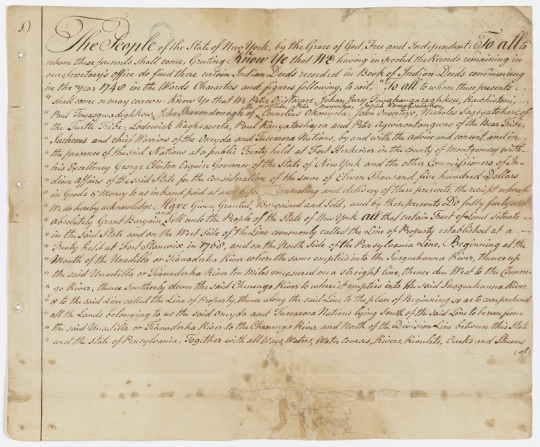


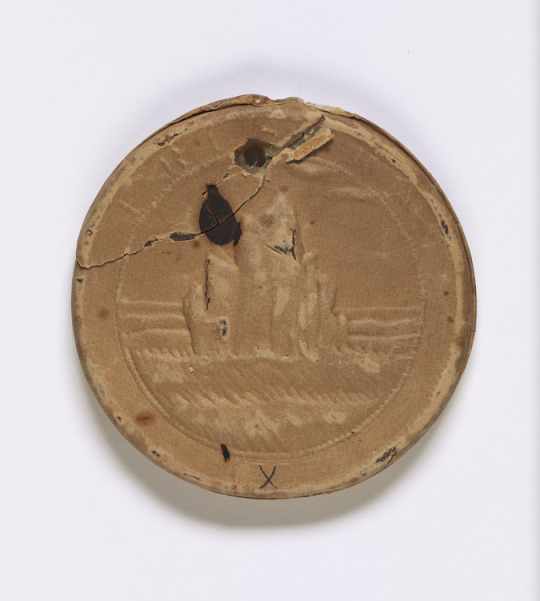
Ratified Indian Treaty 19A (first and last pages), April 11, 1793.
This treaty with the Six Nations (Seneca, Cayuga, Onondaga, Oneida, Mohawk, and Tuscarora) included this wax Great Seal of the State of New York.
Record Group 11: General Records of the United States Government
Series: Indian Treaties
Image description: A circular seal, just over three inches in diameter, made of wax covered with paper. Depicted in the center is a sun with a face, rising over hills. Below the hills is “EXCELSIOR”. Around the border of the seal is “THE GREAT SEAL OF THE STATE OF NEW YORK”. There is a hole through the seal at the top.
Image description: Reverse of the circular seal. In the center are spiky rocks jutting out of the water. There are letters at the top of the border, but it’s difficult to see what they say. At the bottom of the seal is an ink “X”. There is a hole through the seal at the top.
Transcription:
1)
The People of the State of New York, by the Grace of God, Free and Independent: To all to
whom these presents shall come, Greeting Know ye that We having inspected the Records remaining in
our Secretary's Office do find there certain Indian Deeds recorded in Book of Indian Deeds commencing
in the year 1748 in the Words Characters and figures following, to wit, "To all to whom these presents
"shall come or may concern: Know ye that We Peter Ojistarare, Johan Jesry Towahangaraghkou, Rawhistoni,
"Paul Tewasgwadeghkow, John Skanondonagh of the wolf tribe, Peter Oneyanha, Joseph Kanaghsaterhon, Cornilius Okonyota, John Onontiyo, Nicholas Sagoyatokare of
"the Turtle Tribe; Lodowick Kaghsaweta, Paul Kanyatashayea and Peter Agwirontongwas of the Bear Tribe,
"Sachems and chief Warriors of the Oneyda and Tuscarara Nations, by and with the advice and consent and in
"the presence of the said Nations at a public Treaty held at Fort Herkimer in the county of the Montgomery with
"his Excellency George Clinton Esquire Governor of the State of New York and the other Commissioners of In-
"dian Affairs of the said State for the consideration of the sum of Eleven Thousand five hundred Dollars
"in Goods & Money to us in hand paid at and before [illegible] ensealing and delivery of these presents, the receipt whereof
"We do hereby acknowledge Have Given, Granted, Bargained and Sold, and by these presents Do fully freely and
"Absolutely Grant Bargain and Sell unto the People of the State of New York all that certain Tract of Land situate
"in the said State and on the West Side of the Line commonly called the Line of Property established at a
"Treaty held at Fort Stanwix in 1768, and on the North Side of the Pensylvania Line, Beginning at the
"Mouth of the Unadilla or Tianaderha River where the same empties into the Surquchanna River, thence up
"the said Unadilla or Tianaderha River ten Miles measured on a straight line, thence due West to the Chenen-
"go River, thence Southerly down the said Chenengo River to where it empties into the said Sasquchanna River
"& to the said Line called the Line of Property, thence along the said Line to the place of Beginning so as to comprehend
"all the Lands belonging to us the said Oneyda and Tuscarora Nations lying South of the said Line to be run from
"the said Unadilla or Teanaderha River to the Chenengo River and North of the Division Line between this State
"and the State of Pensylvania, Together with all Ways, Waters, Water courses, Rivers, Riverlets, Creeks and Streams
(of)
[page 2]
16.)
"Onaakaronton his x mark LS Tehoghweakaronto his x mark LS Kaghnunrayen his x mark LS Agwirontong-
"waghs his x mark LS Anonghsighraghtha his x mark LS Oniatariyoo his x mark LS Kaneyaggh his x mark
"LS Geo: Clinton LS Pierre Van Cortlandt LS Ezra L Hommedieu LS Abm Ten Broeck LS Peter Gansevoort-
"Junr. LS Richd. Varick LS Witnesses Present Sam Kirkland Missry. Interpreter John Lansing Junr. Jos.
"Brant, David Hill, John Tayler, Malachi Treat, Abm Hardenbergh, Peter Otsiequette, Aghwistonisk his x mark,
"Oneyanka his x mark, Coll. Honyery his [mark] mark, Oneida Chiefs. Onangaiekhon his x mark, Fhoghnawayen
"x Senekas. - Be it Remembered that on the Twenty fifth day of November in the year one thousand seven hundred and
"ninety one before me John Sloss Hobart one of the Justices of the Supreme Court of the State of New York came Samuel Kirkland,
"Clerk, Missionary and Interpreter to the Six Nations of Indians, who made oath that he was present and did see the Twenty
"-Eight Sachems, Chiefs and Warriors of the Onondaga Nation of Indians whose names are written opposite to their respec-
"tive Seals severally seal and deliver the within written Ratification as their Voluntary act and deed for the purposes and uses therein mentioned,
"he having previously thereto faithfully and truly interpreted the Contents of the same from the English into the Indian Language unto the said
"Sachems, Chiefs and Warriors in such a manner that it was fully understood by them and that he also saw the Commissioners on the part of the
"State of New York in the said Ratification Mentioned severally seal and deliver the same as their Voluntary act and deed for the purposes and
"uses therein mentioned, and that John Lansing Junr. and the Eleven other persons whose names are signed as Witnesses were present and did see
"the said parties Seal and deliver the said Ratification; and I having Examined the same and found no material alteration therein do al-
"low it to be recorded Jno. Sloss Hobart. The preceding Instrument refers to the Treaty recorded in pages 150 & which is dated the 12th.
"of September 1788, and is a true copy of the Original, Examined and compared therewith this 5th. day of April 1793 (the words "alias Land Car-
"rier" in page 170 being interlined) By me Robert Harpur D Secry."
~~~~~~~~
All which WE have caused to be Exemplified by these Presents: In Testimony whereof
We have caused these our Letters to be made patent and the Great Seal of our said State to be hereunto affixed Witness
our Trusty and well beloved George Clinton Esquire Governor of our said State General and Commander in chief
of all the Militia and Admiral of the Navy of the same, at our City of New York; this Eleventh day of April in the year of
our Lord one thousand seven hundred and Ninety-Three, and in the Seventeenth year of our Independence.~
#archivesgov#April 11#1793#1700s#Early America#Native American history#American Indian history#Indigenous American history#Iroquois Confederacy#Seneca#Cayuga#Onondaga#Oneida#Mohawk#Tuscarora#New York#Indian treaties
77 notes
·
View notes
Text
The Shot Heard Around the World Chapter 28
The Fight Continues (Wattpad | Ao3)
Table of Contents | Prev | Next
August 6, 1777
Kanien'kehà:ka sometimes wondered how he got into these situations. He knew why he was fighting and knew what Britain had promised him and his people, but he found himself growing tired of war. Especially this war, which had done so much damage to his family and friends, with Rotinonshón:ni dealing with his people choosing opposite sides in this war.
Kanien'kehà:ka wished Skarù:ręˀ and Onyota'a:ka had chosen to fight with him. He hoped that this war did not risk Rotinonshón:ni’s life. At least his son had enough sense to maintain neutrality and refuse to fight, not wanting to divide them any further.
Still, Kanien'kehà:ka had decided to fight in this war, so he couldn’t be one to complain. At least he was being led by Thayendanegea and not some British general. Kanien'kehà:ka had long grown familiar with how they saw him, and he wasn’t a fan of it.
He knew they saw him as lesser, as incompetent, and stupid, and he hated it.
True, there was some British leader whose name he didn’t remember with them, but for the most part, Kanien'kehà:ka was surrounded by his people.
They had been preparing an ambush for the rebels in a small ravine where the trail they knew the rebels were traveling on crossed a stream. The thick undergrowth hid Kanien'kehà:ka and his people as the British blocked the path, ensuring that the rebels would stop and get caught in the trap.
If they stopped the rebels here, it would allow for the British general currently besieging the rebel fort a few miles away to capture it, thus allowing them to gain another victory over the rebels. Despite not being as emotionally invested in this war as the British, Kanien'kehà:ka hoped to win it, knowing that the sooner the war ended, the sooner Rotinonshón:ni could be at peace and they could work to repair broken relationships.
So when Kanien'kehà:ka saw the rebels arriving, he let out a low breath, tensing as he prepared for the ambush. Once the rebels ran into the British, he and his people would swoop in and decimate them, preventing any reinforcements from arriving at Fort Stanwix.
However, before the rebels had reached the British, some of Kanien'kehà:ka’s men fired, alerting the rebels to the ambush. Angry, but knowing there was nothing that could be done about that now, Kanien'kehà:ka raised his gun to fire at the rebels, taking note of the people that were alongside them.
He knew they must be Skarù:ręˀ or Onyota'a:ka’s people. The thought made him angry. He didn’t want to fight them, but at the same time, he felt that they had betrayed him by joining the rebels. What had happened to Onyota'a:ka’s neutrality?
As much as he wanted to target them, some half-hearted, petty revenge, Kanien'kehà:ka looked away from them. There was no use making things any worse. They had picked their sides. Now, they must learn to deal with them.
The battle went on until a thunderstorm began, and everything seemed to ground to a halt. Kanien'kehà:ka sighed, knowing that the battle would be over soon if the rain continued. No one could fight in this weather, and it was better for them all to head home if it didn’t change soon—no use sitting around and waiting for good weather.
While the rain eventually began to subside and fighting half-heartedly resumed, Kanien'kehà:ka’s people eventually began to withdraw. Kanien'kehà:ka didn’t blame them.
He was tired of fighting, too.
• ───────────────── •
August 16, 1777
Vermont had never felt more nervous than when he had been given his gun. He knew he had decided to fight against the British, but being given that weapon made it all the more real. He had to fight in this battle against the British, as they were planning to attack Bennington, a town in Vermont’s country.
This was his chance. He wanted to prove not only himself as a nation but also as a son who would be loyal to his father, the United States of America.
He had answered General John Stark’s call for additional forces alongside many people from his country, like Colonel Seth Warner, and had certainly surprised the man, who did not expect a nation-child to arrive. But General Stark, a hero and veteran soldier who had met Vermont’s father, quickly adapted to the situation and welcomed Vermont into his army.
It had been raining non-stop all day, but as soon as the weather cleared on the afternoon of the sixteenth, Vermont and his father’s army made their move to attack the British at their encampment.
General Stark began to rally the troops, talking about how they were fighting for their natural-born rights as Englishmen. Vermont may not have been American, but the words rallied him, too.
"There are your enemies, the Red Coats, and the Tories. They are ours, or this night, Molly Stark sleeps a widow," General Stark then proclaimed. Vermont tightened his grip on his weapon, both wishing he had more experience and yet still eager to fight.
He was confident they would win this battle, however, as Vermont knew that General Stark had sent Americans disguised as loyalists into the British camp to gather intelligence.
When the attack finally began, Vermont was surprised by how personal it seemed to some of the people he fought alongside.
Then, he remembered how many loyalists had been called in to fight for the British. How many of his people were fighting against family and friends? If he was not only a few months old, a person who had barely left Westminster, would he be fighting friends, killing people he once knew?
Vermont tried to force the thought out of his mind as he continued to fight his way through the British defenses. The battle was loud and chaotic, and there were a few times when Vermont wanted to throw down his weapon and flee, feeling far too young to fight a war.
But he stayed. If he fled, not only would it damage his personal standing with his father and his army, but it would hurt the reputation of his own country, as they would have a countryhuman that was such a coward. This wasn’t just fighting for his father’s army. Vermont was fighting to protect his own people.
He had to stay and fight for them, the people that brought him into existence.
But as the sun began to set, Vermont and the Americans managed to surround the British forces, which surrendered. Vermont had won his first battle, and he couldn’t help the elated grin that spread across his face at that.
He had won.
Bennington was safe.
#countryhumans#statehumans#historical countryhumans#the shot heard around the world by weird#statehumans vermont#countryhumans mohawk
3 notes
·
View notes
Text
Events 11.5 (before 1940)
1138 – Lý Anh Tông is enthroned as emperor of Vietnam at the age of two, beginning a 37-year reign. 1499 – The Catholicon, written in 1464 by Jehan Lagadeuc in Tréguier, is published; this is the first Breton dictionary as well as the first French dictionary. 1556 – Second Battle of Panipat: Fighting begins between the forces of Hem Chandra Vikramaditya, the Hindu king at Delhi and the forces of the Muslim emperor Akbar. 1605 – Gunpowder Plot: Guy Fawkes is arrested in the cellars of the Houses of Parliament, where he had planted gunpowder in an attempt to blow up the building and kill King James I of England. 1688 – Prince William III of Orange lands with a Dutch fleet at Brixham to challenge the rule of King James II of England (James VII of Scotland). 1757 – Seven Years' War: Frederick the Great defeats the allied armies of France and the Holy Roman Empire at the Battle of Rossbach. 1768 – The Treaty of Fort Stanwix is signed, the purpose of which is to adjust the boundary line between Indian lands and white settlements set forth in the Royal Proclamation of 1763 in the Thirteen Colonies. 1780 – French-American forces under Colonel LaBalme are defeated by Miami Chief Little Turtle. 1811 – Salvadoran priest José Matías Delgado rings the bells of La Merced church in San Salvador, calling for insurrection and launching the 1811 Independence Movement. 1828 – Greek War of Independence: The French Morea expedition to recapture Morea (now the Peloponnese) ends when the last Ottoman forces depart the peninsula. 1834 – Founding of the Free University of Brussels by Pierre-Théodore Verhaegen. 1862 – American Civil War: Abraham Lincoln removes George B. McClellan as commander of the Army of the Potomac. 1862 – American Indian Wars: In Minnesota, 303 Dakota warriors are found guilty of rape and murder of whites and are sentenced to death. Thirty-eight are ultimately hanged and the others reprieved. 1872 – Women's suffrage in the United States: In defiance of the law, suffragist Susan B. Anthony votes for the first time, and is later fined $100. 1881 – In New Zealand, 1600 armed volunteers and constabulary field forces led by Minister of Native Affairs John Bryce march on the pacifist Māori settlement at Parihaka, evicting upwards of 2000 residents, and destroying the settlement in the context of the New Zealand land confiscations. 1895 – George B. Selden is granted the first U.S. patent for an automobile. 1898 – Negrese nationalists revolt against Spanish rule and establish the short-lived Republic of Negros. 1911 – After declaring war on the Ottoman Empire on September 29, 1911, Italy annexes Tripoli and Cyrenaica. 1912 – Woodrow Wilson is elected the 28th President of the United States, defeating incumbent William Howard Taft. 1913 – King Otto of Bavaria is deposed by his cousin, Prince Regent Ludwig, who assumes the title Ludwig III. 1914 – World War I: France and the British Empire declare war on the Ottoman Empire. 1916 – The Kingdom of Poland is proclaimed by the Act of 5th November of the emperors of Germany and Austria-Hungary. 1916 – The Everett massacre takes place in Everett, Washington as political differences lead to a shoot-out between the Industrial Workers of the World organizers and local police. 1917 – Lenin calls for the October Revolution. 1917 – Tikhon is elected the Patriarch of Moscow and of the Russian Orthodox Church. 1925 – Secret agent Sidney Reilly, the first "super-spy" of the 20th century, is executed by the OGPU, the secret police of the Soviet Union.
1 note
·
View note
Text
0 notes
Photo



Es ist Samstag und Zeit für ein neues Kapitel bei Alex!
Die Einweihung des Untergrunds kann gefeiert und die Räumlichkeiten bezogen werden.
William Johnson hat sich dem Teehandel verschrieben, was in Mistress Kenway ein Ereignis heraufbeschwört, welches in ein paar Jahren fast seinen Ruin bedeuten könnte! Doch dazu später mehr!
Die gesamte Familie ist bereit für das Portrait! Lange wurde es aufgeschoben, doch nun ist es an der Zeit!
Ich wünsche viel Vergnügen beim Lesen und bitte bleibt gesund!
#FCKCANCER #fckbreastcancer
Liebe Grüße MrsHEKenway
Boston-Tea-Party --> https://de.wikipedia.org/wiki/Boston_Tea_Party
Fort Stanwix --> https://www.britannica.com/event/Treaties-of-Fort-Stanwix
Von schicksalhaften Zeitreisen und dem Ruf der Nornen - Part II - Virginia - Der Untergrund und das Familienportrait (on Wattpad) https://www.wattpad.com/1391676479-von-schicksalhaften-zeitreisen-und-dem-ruf-der?utm_source=web&utm_medium=tumblr&utm_content=share_reading&wp_uname=Mrs_H_E_Kenway&wp_originator=mfogZe4fcGDu9pFAtySwzpCSFceQoWqIxKwTdoLuAmxddyvbYgUO6QZ0LgPAx3IHEih42wa7bVMrfgP9DItJ%2BmM8qdmz7J5bfvUjChNPo7mvCHklzdaOB%2BCbaQDLRnW1 ~~~ Atlantik, 6. August 1768. Die Jackdaw ist auf dem Heimweg nach Virginia. Die Familie Kenway wähnt sich in Sicherheit, bis die Naglfar mit ihrem Kapitän Hrymr auftaucht. Damit starten wir in den zweiten Part und von jetzt an rückt der Revolutionskrieg mit seinen Schattenseiten immer näher. Ratonhnhaké:ton tritt auf den Plan und wird bald zu einer wichtigen Unterstützung, nicht nur für seinen Vater! ~~~
#abenteuer#amerikanischekolonien#assassainscreed3#assassinscreed#assassinscreedrogue#assassinscreedvi#connorkenway#edwardkenway#fanfiction#games#georgewashington#haythaekenway#marquisdelafayette#patrioten#revolutionskrieg#ubisoft#bernatrliches#books#wattpad#amreading
0 notes
Text
Canastota to Utica
Whether we stop 5 minutes or overnight, every time we start up, my legs scream!
As we were leaving Canastota, I caught a picture of one of the low bridges often seen on the Old Erie Canal. These low bridges are where the song lyrics “Low Bridge! – Everybody Down” come from. Don’t want to bang my head on that!

It wasn’t too far down the trail before we got to the first aqueduct of the day. At this point we were still in the Old Erie Canal State Historic Park. I think I read there were 32 aqueducts built on the old Erie Canal.


Here are some of my general observations this morning (without pictures): The clouds were reflecting beautifully in the canal water. With mainly clear skies previous days, I think these clouds were a first. There have been lots of pretty wildflowers along the trail - mainly pink and yellow. There are some leaves on the trail, but not a lot of color other than green in the trees. There are all shades of green on top of the old canal water. We are seeing some browns, dark green, moss green, all the way to neon green.
After leaving the Old Erie Canal Park we had a short bit on the road then all of the sudden we were back on the Barge Canal with a boat coming in. Good timing for us. We got a chance to talk to the lock tender and learn more about the process. It is pretty amazing how quickly the water drops down.

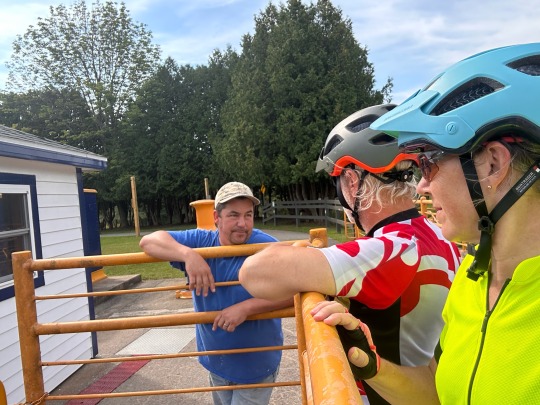
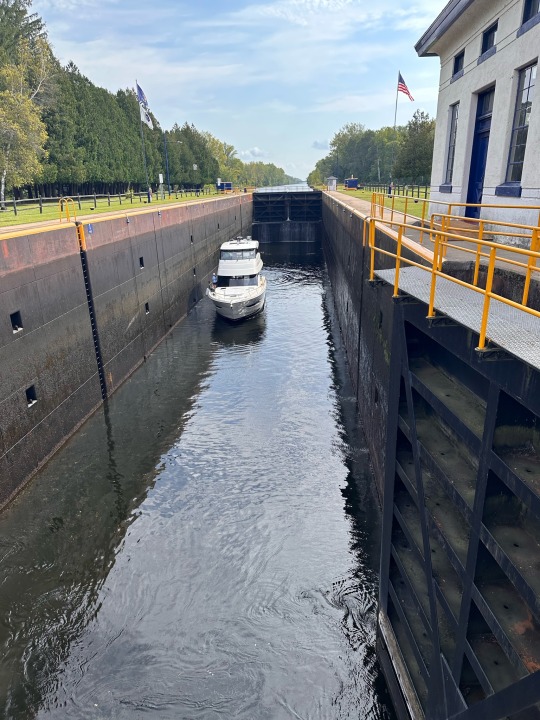
At first he only opens the gates a third of the way open. They do that so they don’t deluge the next lock down too quickly. He eventually opened it all the way to drain it more quickly. When the boat first pulled up, they threw something from the boat to the lock tender. I asked him about that and he said they threw them some food and sometimes a drink. He said she threw him something warm - just cooked wrapped in foil. He said a lot of the boats give them something, but not all.
We were not on the Barge Canal too long. In fact, all of the sudden we were back on the old Erie Canal and didn’t realize when it happened. We are also in the Mohawk River valley now. The water flow for this section of the canal is from the Mohawk River.
We hit the point where the Erie Canal construction began - in the middle. I read they started there because it was an area where locks were not required and they could get two crews working in both directions.

As we pulled into Rome NY, this sign invited us to stop for lunch at JoJo’s Market, so we did! It was great! We also rode around Fort Stanwix in Rome.
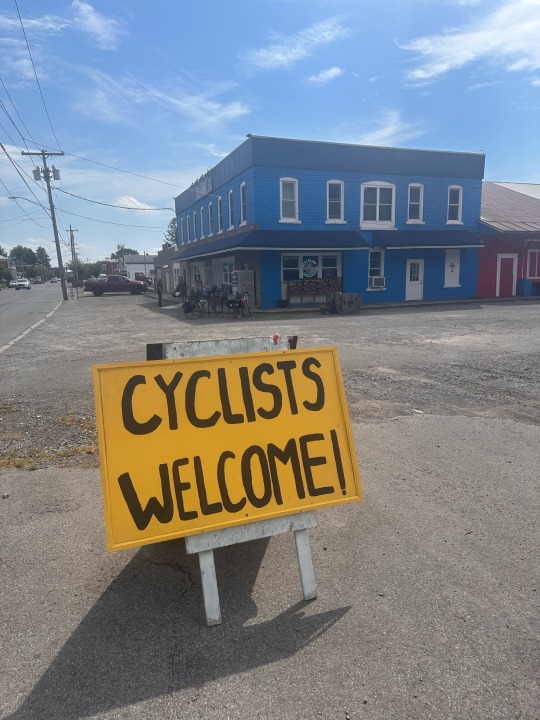

We continued to bounce between the old canal, the Mohawk River, and the Barge Canal.

0 notes
Text
youtube
The song of me turning the historic note of "This Night we sent out a party and brought 2 Stacks of Hay into the Trench and set a House and Barn on Fire belonging to Mr. Roof" into a 1,000 word scene somehow.
#writing music#revolution book 4#historical fiction writing#note comes from a journal entry about the siege of fort stanwix published in a book called days of siege#early morning writing again#also i wish this band would come to the east coast of the us so i can go see them in concert#their music is literally all i listen to when i'm writing revolution
0 notes
Text
working on my extremely diabolically late ass archaeology paper on fort stanwix and going thru the faunal analysis and the ceramic analysis and all that is basically saying that the soldiers there were just generally chillin 😭 like these dudes rarely saw any action except for 1 year where there was like a 3 week period of action AND THEY WON..,, the whole rest of the sparse time it was occupied (1758-1781) the soldiers got consistently fed (despite constant shortages) and had good social relations between them and the officers.. yet the highest crime commited there was for deserting 😩 they rlly said yeah nah this place is just fucking boring LMFAO
#anthropology#like yea of course it would be#why was i expecting something epic to happen in central ny 💀#im kinda loving it tho
0 notes
Photo

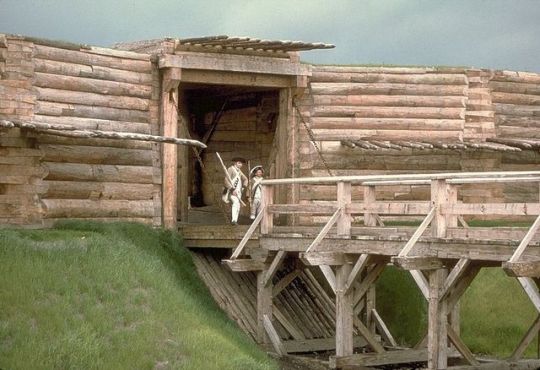
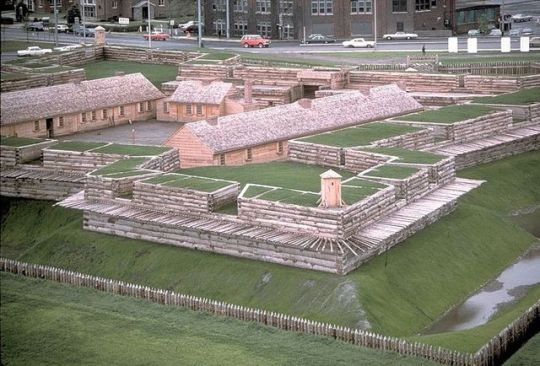
Fort Stanwix.
Fort Stanwix was constructed in 1758 to guard a portage between the main waterway southeastward to the Atlantic seacoast, down the Mohawk and Hudson rivers, and an important interior waterway northwestward to Lake Ontario, down Wood Creek and Oneida Lake to Oswego.
In 1768, Fort Stanwix was the site of an important treaty conference between the British and the Iroquois, arranged by William Johnson. By the time of this treaty, the fort had become dilapidated and inactive. The purpose of the conference was to renegotiate the boundary line between Indian lands and white settlements set forth in the Proclamation of 1763. The British government hoped a new boundary line might bring an end to the rampant frontier violence, which had become costly and troublesome. Indians hoped a new, permanent line might hold back white colonial expansion.
The final treaty was signed on November 5 and extended the earlier proclamation much further west. The Iroquois had effectively ceded Kentucky to the whites. However, the tribes who actually used the Kentucky lands, primarily Shawnee, Delaware, and Cherokee, had no role in the negotiations. Rather than secure peace, the Fort Stanwix treaty helped set the stage for the next round of hostilities.
Fort Stanwix was abandoned in 1768 and allowed to go to ruin.
The fort was reoccupied by Colonial troops under the command of Colonel Elias Dayton on July 12, 1776. They began reconstruction and renamed it Fort Schuyler, although many continued to call it Fort Stanwix. Colonel Peter Gansevoort took over command of the fort on May 3, 1777.
On August 3, 1777, the fort was besieged by The King's 8th Regiment of Foot, Loyalists, and Indians, under the command of Brigadier General Barry St. Leger, as part of a three-pronged campaign to divide the American colonies. Gansevoort refused the terms of surrender offered by the British, and the siege commenced.
According to local folklore, when the Colonial troops raised the flag over the fort on August 3, 1777, it was the first time that the Flag of the United States was flown in battle. It is more likely that the flag flown at Fort Schuyler was one that consisted only of thirteen stripes, an early version of the Flag of New York, or the Grand Union Flag.
The Battle of Oriskany was fought a few miles away when an American relief column, led by General Nicholas Herkimer, was ambushed by Tories and their Indian allies. While many of the besiegers were attending to that battle, the defenders of the fort sallied forth and attacked the enemy camp, looting and destroying enemy stores. Demoralized and reduced in strength, the British withdrew when they heard reports of the approach of yet another relief column, led by General Benedict Arnold. The British forces withdrew through Canada and joined Burgoyne's campaign at Fort Ticonderoga.
The British failure to capture the fort and proceed down the Mohawk Valley was a severe setback and helped lead to the defeat of General John Burgoyne at the Battle of Saratoga.
In April 1779, an expedition from Fort Schuyler against the Onondaga people was begun by the Continental Army led by Col. Goose Van Schaick.
The fort burned to the ground on May 13, 1781 and was not rebuilt. It was abandoned and the garrison took up quarters at Fort Herkimer.
A second Treaty of Fort Stanwix was conducted at the fort between the Americans and the Indians in 1784. During the War of 1812 a blockhouse was built on the parade ground. Beginning in 1828 the fortifications were dismantled.
The fort was designated a National Monument on August 21, 1935. Between 1974 and 1978 the National Park Service reconstructed the fort; a new visitor center was added in 2005. The monument is currently open year around, operated by the National Park Service.
#fort stanwix#seven years war#French and indian war#star fort#history#military history#American history#british army#American revolution#revwar#American war of independence#war of 1812
247 notes
·
View notes
Photo

A lovely silvered and gilt Congressional presentation Smallsword with a blue and gilt blade, presented to Colonel Marinus Willett, attributed to C. Liger, Paris, France, ca. 1785-1786, housed at the Metropolitan Museum of Art. One of ten swords awarded by the Continental Congress. It was presented to Colonel Willett for his actions during the Battle of Oriskany on August 6th, 1777 when he led a sortie out from Fort Stanwix and plundered the nearby native and Tory camp of Sir John Johnson. His force suffered no casualties, earning him the weapon.
#weapons#sword#Smallsword#Blue and gilt#silver#gilt#presentation#Europe#European#France#French#Paris#Parisian#North America#North American#American revolution#Continental Congress#battle of Oriskany#fort Stanwix#Sir John Johnson#Colonel Marinus Willett#C. Liger#early modern#themet#metmuseum#art#history
94 notes
·
View notes
Text
Events 8.22 (before 1900)
392 – Arbogast has Eugenius elected Western Roman Emperor. 851 – Battle of Jengland: Erispoe defeats Charles the Bald near the Breton town of Jengland. 1138 – Battle of the Standard between Scotland and England. 1153 – Crusader–Fatimid wars: The fortress of Ascalon was surrendered by Fatimid Egypt to an army of crusaders, Templars, and Hospitallers led by King Baldwin III of Jerusalem. 1485 – The Battle of Bosworth Field occurs; King Richard III of England's death in battle marks the end of the reigning Plantagenet dynasty and the beginning of the Tudors under Henry VII. 1559 – Spanish archbishop Bartolomé Carranza is arrested for heresy. 1614 – Fettmilch Uprising: Jews are expelled from Frankfurt, Holy Roman Empire, following the plundering of the Judengasse. 1639 – Madras (now Chennai), India, is founded by the British East India Company on a sliver of land bought from local Nayak rulers. 1642 – Charles I raises his standard in Nottingham, which marks the beginning of the English Civil War. 1654 – Jacob Barsimson arrives in New Amsterdam. He is the first known Jewish immigrant to America. 1711 – Britain's Quebec Expedition loses eight ships and almost nine hundred soldiers, sailors and women to rocks at Pointe-aux-Anglais. 1717 – Spanish troops land on Sardinia. 1770 – James Cook names and lands on Possession Island, and claims the east coast of Australia for Britain as New South Wales. 1777 – British forces abandon the Siege of Fort Stanwix after hearing rumors of Continental Army reinforcements. 1780 – James Cook's ship HMS Resolution returns to England (Cook having been killed on Hawaii during the voyage). 1791 – The Haitian slave revolution begins in Saint-Domingue, Haiti. 1798 – French troops land at Kilcummin, County Mayo, Ireland to aid the rebellion. 1827 – José de La Mar becomes President of Peru. 1846 – The Second Federal Republic of Mexico is established. 1849 – Passaleão incident: João Maria Ferreira do Amaral, the governor of Portuguese Macau, is assassinated by a group of Chinese locals, triggering a military confrontation between China and Portugal at the Battle of Passaleão three days after. 1851 – The first America's Cup is won by the yacht America. 1864 – Twelve nations sign the First Geneva Convention, establishing the rules of protection of the victims of armed conflicts. 1875 – The Treaty of Saint Petersburg between Japan and Russia is ratified, providing for the exchange of Sakhalin for the Kuril Islands. 1894 – Mahatma Gandhi forms the Natal Indian Congress (NIC) in order to fight discrimination against Indian traders in Natal.
0 notes
Photo

I spent Memorial Day weekend at Fort Stanwix National Monument in Rome, N.Y. It has a reconstruction of an 18th-century fort that was strategic in the French & Indian War and again later in the Revolutionary War.
44 notes
·
View notes